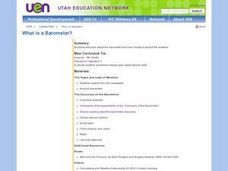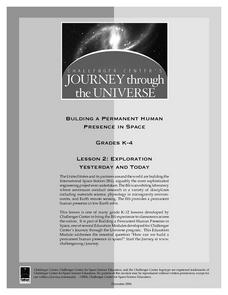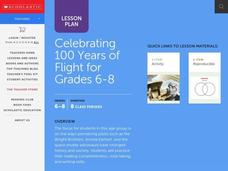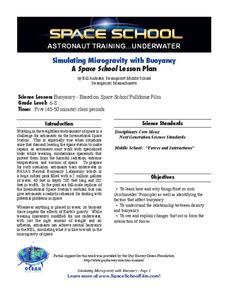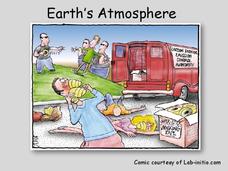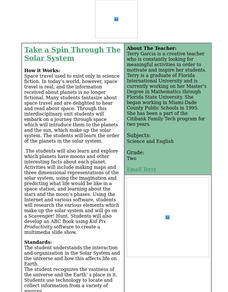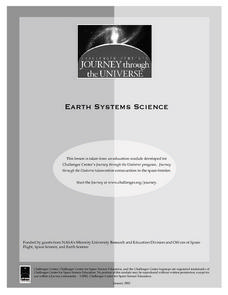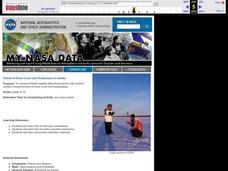Curated OER
Introduction to Gases
Students are introduced to gases. For this science lesson plan, students demonstrate that gases are a state of matter, generate a number of gases, discover some properties of gases, compare some of the properties of different gases, and...
Curated OER
LIFE IN SPACE Human Body: An Un-Earthly Home
Students examine an effect of zero gravity on the human body using a baby food jar, balloons and a jar with a large mouth.
Curated OER
Science Safari: Energy Resources
Learners pick a topic that is related to energy and power companies, tools, and careers. They organize information, photos, illustrations, video, or other graphics into a presentation.
Curated OER
Science NetLinks: Burrowing Owls
Students investigate the example of the burrowing owl to illustrate how human activities can control the fate of species. The research is focused on the ecosystem and examining the different species within it.
Curated OER
Science: What Is a Barometer?
Fourth graders discover how barometers help to predict the weather. Using newspapers, they examine the weather forecast and determine the meaning of high and low as they pertain to pressure. After making cluster diagrams, 4th graders...
Curated OER
Rocket Problems
Learners solve problems related to rockets. They build a space station out of wood and are given an imaginary problem related to construction. They discover how NASA uses problem solving skills to solve issues related to the...
Curated OER
Satellite Tracker
Learners use satellite tracking software to monitor different satellites. They predict and graph the motion of the space station. They create a 3-D display of its path and share it with the class.
Curated OER
The Airplane
Students demonstrate the Bernoulli Principle, review the influences that affected the Wright Brothers, and make and modify paper airplanes. This amazing lesson plan has an excellent structure, and very clear plans for the students to...
Curated OER
Properties of Air
Fourth graders participate in a demonstration lesson using bubbles in which they determine that air fills the bubbles. Next, they work in small groups as they they experiment with the properties of air at separate work stations. After...
Curated OER
Exploration Yesterday and Today
Learners compare and contrast the voyages of early explorers with the space explorations of the present day. After reading the biographies of Benjamin Banneker and Timothy Livengood, students create a Venn Diagram comparing and...
Curated OER
Catch Some Rays?
In this online interactive science rays worksheet, students read 5 questions and choose the multiple choice answer that answers each question correctly. Students answer 1 science question on rays online in the box provided.
Curated OER
An Introduction to the Night Sky and Movement Astronomy
Basically, this is an interactive exploration of educational astronomy software and an app. Young astronomers discover how the apparent motion of the sky relates to Earth's movements and the position of the observer. It is out of this...
Curated OER
Celebrating 100 Years of Flight
Participate in the 100th anniversary of the first flight. In groups, learners use the internet to research the roles the Wright Brothers and Amelia Earhart played in promoting the use of flight. They use the information to write and...
Florida International University
Simulating Microgravity with Buoyancy
How do astronauts know how to live and work in a weightless environment? It doesn't come naturally! Junior physicists conduct experiments to examine the link between buoyancy and microgravity. Each activity illustrates a different aspect...
Science Geek
Earth's Atmosphere
Ozone gas absorbs the harmful UV-B rays and helps protect humans. An informative presentation begins with the layers of the earth's atmosphere, the pressure and temperature in each of the layers, the ozone layer, the ozone cycle, and the...
Curated OER
Making Predictions About Measurement
Upper graders experiment with measurement. They estimate the length, volume, and weight of various objects, then rotate through stations making predictions concerning measurements and then testing their predictions.
Curated OER
The effects of microgravity
Fourth graders are given a scenario in the instructional activity that presents a problem that needs to be solved. They conduct research from multiple sources in order to gather information. This is used to contribute to possible...
Curated OER
Take a Spin Through the Solar System
Second graders participate in a variety of activities to explore the Solar System in this unit.
Curated OER
Weather: It Works, or Not?
Students discover the techniques meteorologists use to examine the atmosphere. In groups, they build their own weather station and observe the various weather conditions. They identify the types of weather patterns that allow the...
Curated OER
Atmospheric Shielding from Radiation I
In this radiation worksheet, students calculate the distance of a satellite in orbit to determine the placement of a radiation detection device. This worksheet has 2 problems to solve.
Curated OER
South Pole Base Gamma
Young scholars design a South Pole base. In this science lesson, students discuss characteristics of the South Pole and work in a group to design a base that will be named "Gamma." Young scholars sketch their design.
Curated OER
Trends of Snow Cover and Temperature in Alaska
Students gather historical snow cover and temperature data from the MY NASA DATA Web site. They compare this data to data gathered using ground measurements from the ALISON Web site for Shageluk Lake. They graph both sets of data and...
Curated OER
Biological Relationships
Create a written document to show knowledge of producers, consumers, decomposers, and symbiotic relationships. To investigate food consumption, your classes will differentiate between types of symbiosis and explain examples of each.
US Environmental Protection Agency
Tree Rings: Living Records of Climate
Open with a discussion on weather and climate and then explain how tree rings can provide scientists with information about the earth's past climate. Pupils analyze graphics of simulated tree rings from various US locations for the...






